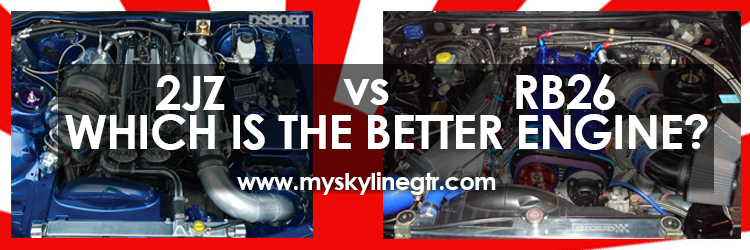Speak to Japanese performance car enthusiasts you’ll get a wide range of opinions on the best performance cars from the land of the rising sun. The main candidates would be the GT-R, Supra, NSX or Evo. But when it comes down to the topic of best performance engine in the last generation of Japanese performance cars the debate narrows down to two engines. The RB26 and the 2JZ. It is the reason today that I want to set this argument straight and discuss which is the better engine? The Rb26 or 2JZ?
Before we get into the topic of which is a better engine
Disclaimer: I am not discussing which is a better car; GT-R or Supra. I am simply discussing which is a better engine in stock and modified form. Which engine is more reliable, which engine has the most potential. My criteria will be based on how much power the engine can handle in standard form, minor mods and finally full forged builds.
RB26 engine
Pros
- VVTI is amazing and tuning can be easily done without complications unlike the 2JZ
- High raving motor which has a big range to make power
- The standard twins are not sequential and deliver good power and response
- Individual throttle bodies (ITB)
- Standard RB26 motor will see you get 300 rwkw on pump and around 350 rwkw on e85
Cons
- Oil starvation as the standard sumps and oil pump are the Achilles heel of the engine
- .4L less capacity to the 3.0 litres the 2JZ has
- Cost of getting spare parts is high as RB26 parts are very rare
- Cost a lot of money to get the engine in a form to handle anything over 400 rwkw
2JZ engine
Pros
- Non interference head (valves won’t hit piston if the timing belt breaks as in the case of Rb26 engines. Learn more about interference heads)
- Easily get 400+ rwkw from a standard bottom end just by slapping a mid sized single turbo with external gate. Capable of 1500 rwkw in modified form.
- Extra .4 litres over the Rb26
- Square engine bore and stroke (if stroke of engine is less than bore, friction increases due to larger forces on the cranks bearing. Here’s a great article that explains the phenomenon in depth in regards to the issues faced with not having a square bore and stroke.)
- Engine lubrication and cooling systems are good for 800 rwkw
- From my research the 2JZ’s come with a forged crank
Cons
- Sequential turbo system is ancient technology prone to failure
- VVTI is harder to tune than the RB26 version
- Oil pump seal known to blow out
- Crank pulley can come apart
My thoughts about both engines
Both engines are capable of incredible power figures and a small fortune can be spent on both engines chasing these power figures. But one engine in both standard and modified forms excels past the other. As a GT-R owner and lover of the car I freely admit that the 2JZ beats the RB26 hands down. The power that can be made by a 2JZ with minimal mods tips the argument in its favour.
For example, 15 years ago (and the prices aren’t much different these days) for me to break over 400 rwkw in my GT-R it costed me nearly 30K on an engine build. During the same time the Supra boys were pulling the same figures spending around 7K. Look at today’s technology going into these engines; there are stroker kits on the market taking the 2JZ displacement out to 3.8 litres. Where as the RB26’s using the RB26 block can only be taken out to 3 litres. That extra capacity makes a difference on the street!
So the argument is over! The 2JZ is better than the RB26.

